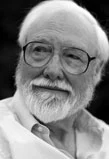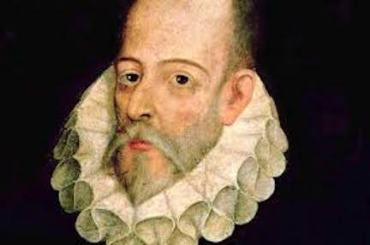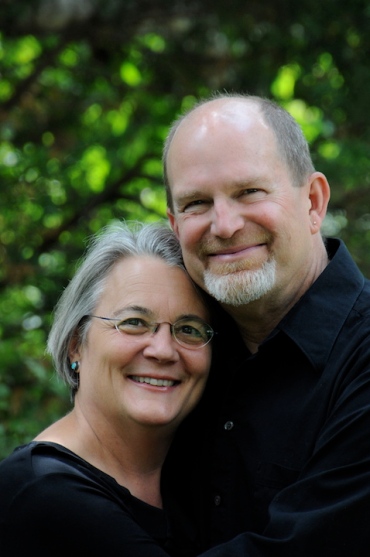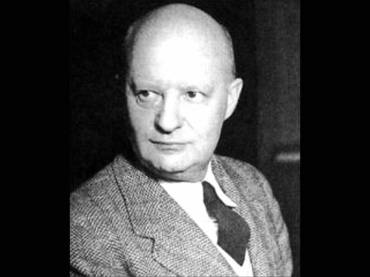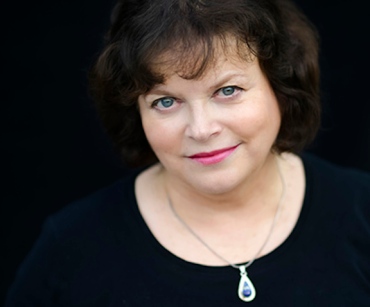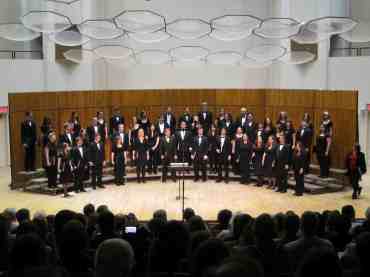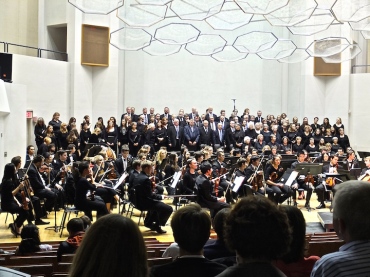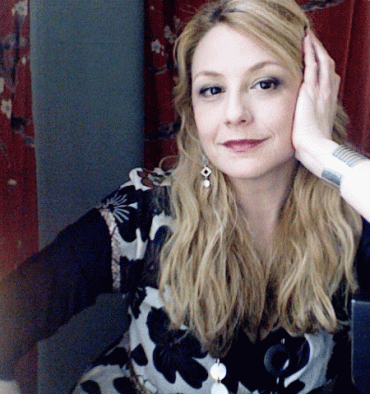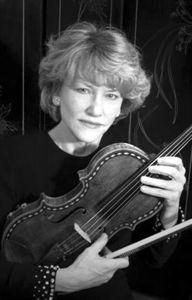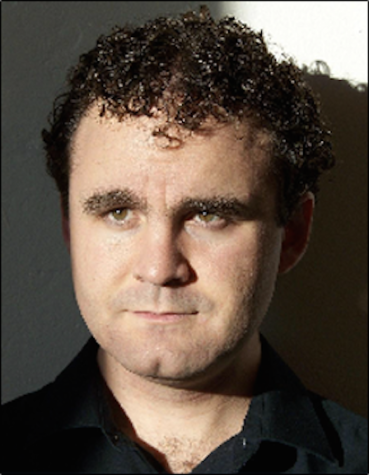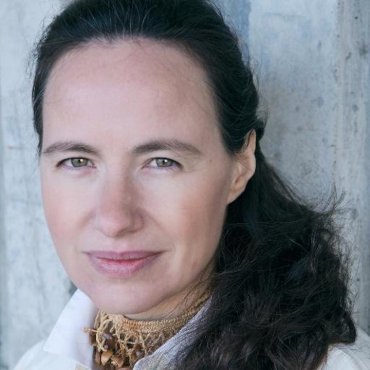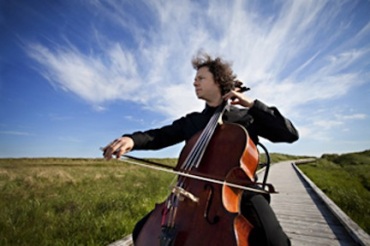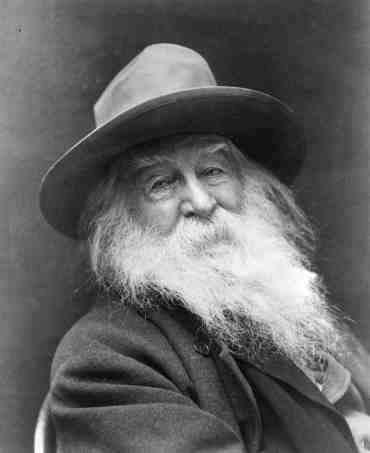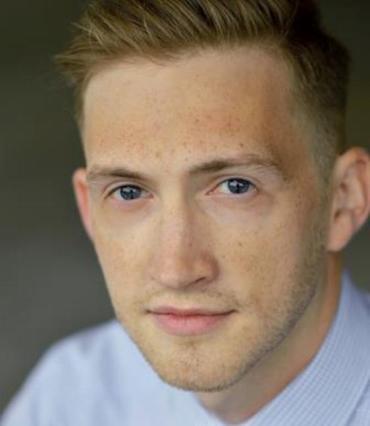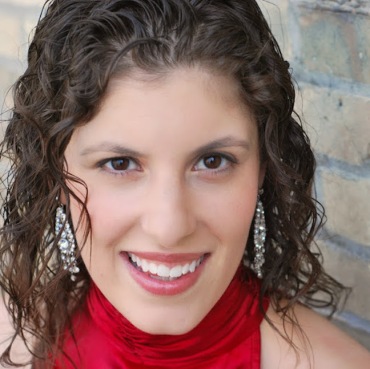The Well-Tempered Ear
Classical music: The Choir of Trinity College Cambridge sings a varied program with organ accompaniment this Wednesday night in Overture Hall
Leave a Comment
IF YOU LIKE A CERTAIN BLOG POST, PLEASE SPREAD THE WORD. FORWARD A LINK TO IT OR, SHARE IT or TAG IT (not just “Like” it) ON FACEBOOK. Performers can use the extra exposure to draw potential audience members to an event. And you might even attract new readers and subscribers to the blog.
By Jacob Stockinger
The new season of the popular Overture Concert Organ series, sponsored by the Madison Symphony Orchestra and curated by MSO organist Greg Zelek, begins this Wednesday night, Sept. 11, at 7:30 p.m. in Overture Hall.
All single tickets are $20. (A subscription to all four organ concerts is $63.)
The opening program features the world-famous Choir of Trinity College Cambridge (below), on tour from its home in the United Kingdom.
Adds Zelek:
“Our season opens with the amazing Choir of Trinity College Cambridge, named by Gramophone Magazine as one of the best choirs in the world.
“Conducted by the choir’s music director Stephen Layton (below top) and accompanied on the mighty Klais concert organ (below bottom), this 25-voice choir will present a program of music spanning many centuries that will display its beauty of tone and depth of feeling. These rich voices will make this varied program soar through Overture Hall and leave everyone in the audience breathless.”
Here are some sample reviews:
Virtuoso is the right word. I, for one, can’t immediately think of any more appropriate way of describing singing of such staggering accomplishment. – BBC Music Magazine
Sitting front and center at a recent Trinity Choir of Cambridge concert at Grace Cathedral was, sonically speaking, a heavenly experience. -The New York Times
Here is Wednesday night’s eclectic program:
William Byrd | Sing joyfully
William Byrd | O Lord, make thy servant, Elizabeth
Thomas Tallis | Salvator mundi
Henry Purcell | Thou knowest, Lord
Arvo Part | Bogoroditse Djévo
John Tavener | Mother of God, here I stand
Vasily Kalinnikov | Bogoroditse Djevo
Robert Parsons | Ave Maria
Eriks Esenvalds | The Heavens’ Flock (You can hear a different Esenvalds work, “Only in Sleep,” sung by the Trinity College Choir, in the YouTube video at the bottom.)
Morten Lauridsen | O magnum mysterium
Jaakko Mantyjarvi | Stuttgarter Psalmen
Herbert Howells | Take him, earth, for cherishing
Herbert Howells | Trinity St. Paul’s
For more information about the Overture Organ Series, detailed background about the Trinity College Choir and how to purchase tickets, call (608) 258-4141 or go to: https://madisonsymphony.org/concerts-events/overture-concert-organ-performances/ or https://madisonsymphony.org/event/organ-trinity-choir/
Tags: #ArvoPärt, #AveMaria, #BBCMusicMagazine, #BlogPost, #BlogPosting, #CambridgeUniversity, #ChoirofTrinityCollegeCambridge, #ChoralDirector, #ChoralMusic, #ConcertOrgan, #DepthofFeeling, #EnglishComposer, #EriksEsenvalds, #FacebookPost, #FacebookPosting, #GraceCathedral, #GramophoneMagazine, #GreatBritain, #GregZelek, #HenryPurcell, #HerbertHowells, #HomeWebsite, #JaakkoMantyvari, #JohnTavener, #KlaisOrgan, #KlaisOrgelbau, #LIturgicalMusic, #MadisonSymphonyOrchestra, #MortenLauridsen, #MotherofGod, #MusicDirector, #MusicReview, #NewMusic, #OMagnumMysterium, #OrganMusic, #OvertureCenter, #OvertureHall, #OvertureOrganSeries, #RobertParsons, #SacredMusic, #September11, #StephenLayton, #SubscriptionConcert, #SubscriptionTicket, #TheNewYorkTImes, #ThomasTallis, #TonalBeauty, #TrinityCollege, #UnitedKingdom, #VasilyKalinnikov, #VocalMusic, #Wednesdaynight, #WilliamByrd, #World-famous, #YouTubevideo, accomplishment, amazing, Arvo Part, audience, Ave Maria, BBC, BBC Music Magazine, beauty, best, blog, breathless, Cambridge University, cathedral, Catholic, centuries, Choir, Choir of Trinity College Cambridge, choral director, choral music, Classical music, classicalmusic, composer, concert organ, curate, depth, depth of feeling, describe, detail, director, Earth, eclectic, England, English, Eriks Esenvalds, everyone, experience, Facebook, famous, feeling, flock, forward, God, grace, Grace Cathedral, Gramophone, Gramophone (magazine), Great Britain, Greg Zelek, heaven, heavenly, Henry Purcell, Herbert Howells, Home, information, Jaakko Mantyvari, John Tavener, Joy, joyful, like, link, liturgical, liturgical music, Lord, Madison Symphony Orchestra, Morten Lauridsen, Mother, Mother of God, Music, Music director, music review, new, New Music, night, O magnum mysterium, opening, organ, organ music, organist, Overture Center, Overture Concert Organ, Overture Hall, Overture Organ Series, performer, popular, post, posting, program, Protestant, psalm, reader, review, rich, Robert Parsons, sacred music, savior, Season, Sept. 11, September 11, series, servant, share, sing, singer, Singing, single, Sleep, soar, sonic, St. Paul, staggering, Stephen Layton, Stuttgart, subscriber, subscription, tag, The New York Times, Thomas Tallis, ticket, tonal beauty, tone, tour, Trinity College, U.K., UK, United Kingdom, Vasily Kalinnikov, video, virtuoso, vocal music, voices, Website, Wednesday, William Byrd, world, YouTube
Classical music: The talented new director of the Isthmus Vocal Ensemble sets the acclaimed and still impressive group on a new path with mixed results and hopeful expectations
6 Comments
By Jacob Stockinger
Here is a special posting, a review written by frequent guest critic and writer for this blog, John W. Barker. Barker (below) is an emeritus professor of Medieval history at the University of Wisconsin-Madison. He also is a well-known classical music critic who writes for Isthmus and the American Record Guide, and who hosts an early music show once a month on Sunday morning on WORT-FM 89.9 FM. For years, he served on the Board of Advisors for the Madison Early Music Festival and frequently gives pre-concert lectures in Madison. He also took the performance photos.
By John W. Barker
The Isthmus Vocal Ensemble (IVE, below) is a well-established part of Madison’s musical summers. It offers dedicated choral singers a chance for intensive rehearsal preparation of highly accomplished choral music, and has delivered some truly memorable events over the years.
Of its concerts this year, I caught the second performance on Sunday afternoon. The choir itself doesn’t need to be shown off by now, but it was the choir’s chance to show off its new conductor in his first appearance here.
Michael McGaghie (below) is that new conductor. He is very plainly a brilliant choral technician who knows how to make a choir sound wonderful. (For more about McGaghie, who is the Director of Choral Activities at Macalester Collge in St. Paul and who leads the Harvard Glee Club Alumni Chorus in Cambridge, Mass., go to: https://www.isthmusvocalensemble.org/artisticdirector/)
That he did throughout the program. The IVE — 69 singers strong — certainly responded with an infectious enthusiasm that was also communicated to the large audience that filled the Christ Presbyterian Church. The concert was certainly a feast of great choral singing.
But what about the music?
To begin with, the actual music amounted to no more than about an hour’s worth. McGaghie planned the program as a progress of emotional moods, and he introduced each piece himself.
But what were the contents? McGaghie largely turned his back on the centuries of great choral music, the kind that his predecessor Scott MacPherson explored so ambitiously.
There were, at the beginning, two examples of that, motets by Thomas Tallis of the 16th century and Heinrich Schütz of the 17th century.
There was also an interesting nugget from the Russian composer and conductor Nikolai Golovanov (below), an early work of his (1917), setting the Lord’s Prayer (Otche naš) In a style departing from the previous two centuries of great Russian Orthodox choral writing.
Beyond those, however, the remaining nine items in the program — and the encore — were entirely by recent composers, mostly living and mostly American. These were his introductory calling cards, and so they invite scrutiny.
Ours is not an age of great, idiomatic choral writing, and composers go their own ways variously. Many of them rely upon a kind of chordal declamation with little sense of line or full-bodied texture.
Some pieces I don’t think I would want to hear again, and a couple I would not have wanted to hear even the first time.
An example of the latter is a piece about sirens and sailors by Chinese-American Chen Yi (below top), a collage of weird choral sounds but no musical content recognizable to any but Chinese ears.
Another was a loudly trashy adaptation of a Civil Rights “freedom song” by Jeffrey Douma (below bottom), plus the gesture to multicultural triviality in a Philippine folksong arrangement.
Three of the items came with piano accompaniment. In The Whole Sea in Motion by Dale Trumbore (below top) — which uses a text from Anne Brontë — the piano gave an underlying ripple to support declamatory, non-linear writing.
In Eternity by Donald Martino (below), the pleasantly lyrical choral writing really didn’t need the piano at all. And that part was much too prominent against Morten Lauridsen’s nicely polyphonic, and quite self-sufficient, choral texture in “Sure on This Shining Night” that treated James Agee’s famous poem. (You can hear the Lauridsen work in the YouTube video at the bottom.)
There were certainly some among these contemporary items that I found quite enjoyable.
In Ophelia, a setting the account of that woman’s death in Hamlet, Jocelyn Hagen (below top) was overly concerned with story-telling, but the work certainly contained some lovely writing. O Radiant Dawn by Scottish master James MacMillan (below bottom) was a beautifully sonorous tribute to Catholic liturgical tradition.
What does this conducting debut point to for the future?
McGaghie can create the most splendid choral beauty — though often at the sacrifice of clear diction. On the basis of this program, it looks like he could now focus the IVE on lots of short contemporary pieces, rather than on the vast traditional literature.
We will have to see.
Tags: #Americancomposers, #AmericanRecordGuide, #AnneBrontë, #BlogPost, #BlogPosting, #CambridgeMassachusetts, #ChenYi, #ChoralMusic, #ChristianChurch, #ChristianReligion, #ChristPresbyterianChurch, #CivilRights, #DaleTrumbore, #DonaldMartino, #EmeritusProfessor, #GleeClub, #HarvardUniversity, #HeinrichSchütz, #IsthmusNewspaper, #IsthmusVocalEnsemble, #JamesAgee, #JamesMacMillan, #JeffreyDouma, #JesusChrist, #JocelynHagen, #JohnW.Barker, #Lord'sPrayer, #MacalesterCollege, #MadisonEarlyMusicFestival, #MedievalHistory, #MichaelMcGaghie, #MortenLauridsen, #MusicCritic, #NikolaiGolovanov, #PianoAccompaniment, #PolyphonicMusic, #RomanCatholicism, #RussianComposer, #ScottMacPherson, #St.PaulMinnesota, #ThomasTallis, #UniversityofWisconsin, #UniversityofWisconsin-Madison, #WilliamShakespeare, #WORT-FM89.9, 16th century, 17th century, accompaniment, alumni, American Record Guide, Anne Brontë, arrangement, Arts, Baroque, beauty, brilliant, Chen Yi, Chinese, Chinese-American, Choir, choral, choral music, chordal, Christ, Christ Presbyterian Church, church, civil rights, Classical music, classicalmusic, collage, composer, Concert, conductor, Dale Trumbore, declamation, director, Donald Martino, Early music, earlymusic, emeritus, emotion, emotional, enthusiasm, event, famous, feast, folk song, folksong, gesture, Glee Club, Hamlet, Harvard, Heinrich Schütz, History, infectious, Isthmus, Isthmus Vocal Ensemble, Jacob Stockinger, James Agee, James MacMillan, Jesus, Jesus Christ, Jocelyn Hagen, John W. Barker, lecture, liturgical, Lord, Lord's Prayer, Madison, Madison Early Music Festival, Medieval, MEMF, memorable, Michael McGaghie, Morten Lauridsen, motet, multicultural, Music, Nikolai Golovanov, Ophelia, Philippine, photo, Piano, piece, plan, poem, Poetry, polyphonic, polyphony, prayer, Presbyterian, professor, program, recent, rehearsal, Roman Catholicism, Russian, Scotland, Scott MacPherson, Scottish, sea, Shakespeare, singer, Singing, St. Paul, summer, Thomas Tallis, tribute, triviality, United States, University of Wisconsin-Madison School of Music, University of Wisconsin–Madison, vocal music, Wisconsin, WORT-FM 89.9, YouTube
Classical music: Starting this Friday, the Madison Early Music Festival will devote a week to exploring familiar and unfamiliar Iberian music during the age of Cervantes. Part 1 of 2
1 Comment
By Jacob Stockinger
This coming Friday, when the Madison Early Music Festival (MEMF) starts its week-long exploration of Iberian music during the Renaissance Age of novelist Miguel de Cervantes (below) and his pioneering novel “Don Quixote,” much will be familiar but much will also be new.
To provide a look at what to expect, the longtime co-artistic directors of the festival – wife-and-husband singers soprano Cheryl Bensman Rowe and baritone Paul Rowe (below) – provided the following overview through an email Q&A with The Ear.
All-festival passes are $90 and tickets to individual concerts cost $20, $10 for students.
Click here to buy online, call 608-265-ARTS (2787), or visit the Campus Arts Ticket Box Offices in Memorial Union or Vilas Hall (click here for hours).
(Note: All MEMF Concert Series concerts and lectures are free for participants in the MEMF Workshop. There is a $4 transaction fee per ticket when purchasing online or by phone.)
How successful is this year’s festival compared to others in terms of enrollment, budgets, performers, etc.? How does this program of MEMF’s reach nationally or even internationally compare to previous years?
We will have about 100 students at our workshop this summer, which has been a steady number for the past five years. Our budget increased to cover the big Don Quixote project by Piffaro, which you can read about below.
We continue to attract workshop participants and performers from all over the United States and Canada, and this year our concert series will present Xavier Diaz-Latorre from Spain. For more information, go to: www.xavierdiazlatorre.com
What is new and what is the same in terms of format, students, faculty members and performers?
The following events are new to MEMF this summer:
The Historical Harp Society will be giving a conference before MEMF begins, from Thursday, July 6 through Saturday, July 8, with classes and lectures that will culminate in a concert of Harp Music from the Spanish Golden Age on Friday, July 7, at 7:30 p.m. in Morphy Recital Hall, which is FREE and open to the public. Go to www.historicalharpsociety.org
Master teacher and performer Xavier Diaz-Latorre will be giving a master class in Morphy Recital Hall on Saturday, July 8, from 10 a.m. to noon. It is free and open to the public.
We have a new partnership with the Latin American, Caribbean, and Iberian Studies (LACIS) Program at UW-Madison. LACIS has helped us translate materials and supported MEMF with two grants. www.lacis.wisc.edu
A new display in the Memorial Library foyer will celebrate the 2017 Madison Early Music Festival with a special exhibit of Don Quixote Through the Ages, featuring a selection of books, musical scores, and other materials from the UW-Madison Libraries. While viewing the exhibition, patrons can scan a QR code and listen to a Spotify playlist featuring music that will be heard at the MEMF 2017 Concert Series! This is a MEMF first, created by co-artistic director Paul Rowe.
We worked with several librarians to select the materials: Paloma Celis-Carbajal, Ibero-American Studies and Romance Languages Librarian; Jeanette Casey, head of Mills Music Library; and Lisa Wettleson from Special Collections at Memorial Library (below, in a photo by Brent Nicastro).
Dates: June 26 – August 10, 2017
Location: Memorial Library foyer | 728 State Street | Madison
Library Hours: 8 a.m.-9:45 p.m.
We have several new performers this year.
Xavier Diaz-Latorre, a vihuela player from Spain, and the ensemble Sonnambula from New York. Xavier is a world-renowned musician, and plays the vihuela, a Spanish Renaissance type of guitar, and the lute.
Xavier will perform a solo recital featuring music of the vihuela by composers Luis Narváez, Alonso Mudarra, Gaspar Sanz and Santiago de Murcia. The link below will give you more information about the predecessors to the guitar:
http://www.cs.dartmouth.edu/~lsa/aboutLute/Vihuela.html
Daphna Mor and Kane Mathis will present a program featuring music from the geographic regions of Andalusia, North Africa, the Ottoman Empire and the Sephardic Diaspora. Based on the monophonic music of modes referred to as the Makam, the audience will be drawn to distinct beauty and great similarities of music from the courts, liturgical forms, dance airs and folk music.
Daphna Mor (below top) sings and plays several historical wind instruments, and Kane Mathis (below bottom) plays the oud, a lute type of stringed instrument with 11 or 13 strings grouped in 5 or 6 courses, commonly used in Middle Eastern music.
Percussionist Shane Shanahan (below) will join them. Shane is an original member of the Silk Road Ensemble with Yo-Yo Ma and a Grammy award winner. https://www.stepsnyc.com/faculty/bio/Shane-Shanahan/
And watch Shane play frame drum in the Cave Temples of Dunhuang at the Getty Museum:
https://www.youtube.com/watch?v=tQjC3y6CXQ8
Hear and read about Daphna Mor: http://www.daphnamor.com/
You can watch Kane Mathis play the oud at this link:
https://www.youtube.com/watch?v=7tHrxEohai8
Sonnambula (below), an ensemble of violins and viol da gambas, has performed at the Metropolitan Museum of Art, and have a regular series at the Hispanic Society of America in New York. It played a sold-out program of Spanish Golden Age works drawn from the over 450 pieces in the Cancionero Musical de Palacio, a manuscript at the Royal Palace of Madrid. This same program will be presented at MEMF on Friday, July 14. (You can hear them perform Spanish music in the YouTube video at the bottom.)
Why was the theme of the Spain’s Golden Age and The Age of Cervantes and Don Quixote chosen for the festival? What composers and works will be highlighted?
We liked the connection with last year’s theme, Shakespeare 400, because, although they never knew one another, Cervantes and Shakespeare (below) were contemporaries and share a “deathaversary,” as they both died on April 23, 1616. They led quite different lives, as Shakespeare was very successful throughout his lifetime and Cervantes wasn’t well known until the end of his life, when Don Quixote was published in 1605.
http://www.dw.com/en/shakespeare-and-cervantes-two-geniuses-and-one-death-date/a-19203237
Also, the Renaissance band Piffaro (below, in a photo by Church Street Studios) — an ensemble from Philadelphia that is well loved by MEMF audiences — suggested we explore this connection to Don Quixote and present their program The Musical World of Don Quixote, a huge project that they have been researching for several years.
They created a musical soundtrack to the novel in chronological order, and their program will open our 2017 concert series. This link from the Early Music America article “Piffaro Tilts At Musical Windmills” will tell you about their project in depth:
https://www.earlymusicamerica.org/web-articles/emag-piffaro-tilts-at-musical-windmills/
The other concerts in the series draw from the music that is mentioned in Don Quixote and from the Spanish Renaissance, known as Siglo de Oro, or the Century of Gold. Many composers from this time period will be represented: Tomás Luis de Victoria, Cristóbal de Morales, Francisco Guerrero, Luis de Milán and Alonso Lobo
https://en.wikipedia.org/wiki/Spanish_Golden_Age
https://artsinstitute.wisc.edu/memf/concerts.htm
Check out our website for the most up-to-date information and how to get tickets:
Tomorrow: What makes Renaissance music in Spain different? What composers and music will be featured in concerts?
Tags: air, Alonso Lobo, Alonso Mudarra, American, Andalusia, Arts, award, baritone, Baroque, beauty, Book, budget, Canada, cave, Cello, Cervantes, Chamber music, Cheryl Bensman Rowe, choral music, class, Classical music, Concert, concerto, court, Cristóbal de Morales, dance, Daphna Mor, diaspora, Don Quixote, Early music, Early Music America, enrolllment, exhibit, explore, faculty, familiar, festival, folk, Folk music, Francisco Guerrero, Gaspar Sanz, Getty Museum, Golden Age, Grammy, guitar, harp, Hispanic, Hispanic Society of America, historical, History, Iberian, Iberian Peninsula, Jacob Stockinger, Kane Mathis, lecture, librarian, library, liturgical, liturgical music, liturgy, Luis de Milan, Luis Narvaez, lute, Madison, Madison Early Music Festival, Madrid, manuscript, master class, Memorial Library, Metropolitan Museum of Art, Middle East, Middle Eastern, mode, monophonic, Music, music library, new, New York, New York City, North Africa, novel, novelist, Ottoman Empire, palace, participants, patrons, Paul Rowe, performer, Piffaro, playlist, rare books, Renaissance, Romance language, royal, sacred, Santiago de Murcia, score, secular, Sephardic, Shakespeare, Shane Shanahan, Silk Road Ensemble, soprano, Spain, special collections, Spotify, strings, temple, theme, ticket, Tomas Luis de Victoria, U.S., United States, University of Wisconsin-Madison School of Music, University of Wisconsin–Madison, US, video, vihuela, viol da gamba, Viola, Violin, vocal music, windmill, winds, Wisconsin, work, workshop, Xavier Diaz-Latorre, Yo-Yo Ma, YouTube
Classical music: UW Choral Union and UW Symphony Orchestra resurrect Paul Hindemith’s long-neglected 20th-century secular Requiem with fine singing and committed playing
Leave a Comment
By Jacob Stockinger
Here is a special posting, a review written by frequent guest critic and writer for this blog, John W. Barker. Barker (below) is an emeritus professor of Medieval history at the University of Wisconsin-Madison. He also is a well-known classical music critic who writes for Isthmus and the American Record Guide, and who hosts an early music show once a month on Sunday morning on WORT FM 89.9 FM. For years, he served on the Board of Advisors for the Madison Early Music Festival and frequently gives pre-concert lectures in Madison. He also took the performance photographs below.
By John W. Barker
It is unusual that, within the space of a few days, we have parallel performances of two very untraditional Requiems, ones setting vernacular texts rather than liturgical Latin ones.
The UW Choral Union and UW Symphony(below) performed Paul Hindemith’s “When Lilacs Last in the Dooryard Bloom’d: A Requiem For those we love” last weekend. And the Madison Symphony Chorus and Orchestra will give us Johannes Brahms’ Ein deutsches Requiem (A German Requiem) this coming weekend, May 5-7.
(NOTE: Here is a link with more information about the three MSO performances this coming weekend:
It is hard to resist the temptation to compare them.
They were, of course, composed about a century apart, in the contexts of very different stylistic eras. They reflect very different aesthetics: High Romantic warmth for Brahms, conservative modernism for Hindemith.
The different texts chosen also determine crucial differences. Brahms selected Luther’s German translations of passages from Scripture, as a broad collage of human consolation and solace, whereas the German-born Hindemith, a naturalized American citizen who fled from Hitler’s Nazism, in a patriotic commemoration of the death of President Franklin Delano Roosevelt, chose the long poem of grieving that Walt Whitman (below) wrote over the death of President Abraham Lincoln.
The relatively concise Scriptural texts allowed Brahms to develop rich melodic and contrapuntal elaborations. Hindemith’s determination to set Whitman’s complete poem, of 208 verses in altogether irregular free verse, committed him to keep things in constantly moving continuity, with little chance for pausing and elaborating.
To be sure, Hindemith (below) was never a distinguished lyricist, for all his skills, so his writing is endless declamation by the soloists, backed by strongly cast choral statements. (You can hear famed baritone Dietrich Fischer-Dieskau and the chorus sing the opening of the Hindemith requiem in the YouTube video at the bottom.)
There are many lovely and powerful moments, but they pass by quickly and leave little of memorable expressiveness. There is much clever music here, but in sum total it is more dutiful than beautiful.
The performance in Mills Hall — I heard the one Sunday night — showed a stage packed with musicians. There were two soloists, a chorus of exactly 100 singers, and an orchestra (the UW Symphony) of 67 players, 46 of them on strings. UW choral director and conductor Beverly Taylor (below) drew from all of them deeply committed musical results.
Of the two soloists, soprano Jennifer D’Agostino (below left) sang with beauty and expression, but it was baritone James Held (below right) who stole the show, with a ringing voice, superb diction, and a genuine eloquence.
The huge chorus was quite magnificent, well unified, fully serious in its enunciation, and capable of some truly musical sound — and Hindemith, though nowhere near Brahms as a choral composer, gave them some serious challenges. The orchestra sounded a bit rough at the very beginning, but settled into participating strongly in the performance.
Whatever reservations one may have about Hindemith’s score, this Whitman Requiem, one of his last important works and premiered in 1946, is a significant piece. It is far less frequently heard than that by Brahms, and so it is very good that UW choral director Beverly Taylor has brought it to our attention.
Tags: A German Requiem (Brahms), Abraham Lincoln, American, American Record Guide, Arts, baritone, Beverly Taylor, blog, choral music, citizen, Classical music, collage, composer, conservative, consolation, counterpoint, critic, declamation, Dietrich Fischer-Dieskau, Early music, expressiveness, FDR, Franklin D. Roosevelt, Franklin Delano Roosevelt, free verse, German, History, Hitler, Isthmus, Jacob Stockinger, Johannes Brahms, John DeMain, John W. Barker, Latin, Latin America, lecture, liturgical, liturgy, lyric, lyricist, Madison, Madison Early Music Festival, Madison Symphony Orchestra, Medieval, melody, MEMF, memorable, modernism, Music, Nazi, Nazism, Paul Hindemith, photo, photographs, poet, Poetry, poiem, President, professor, Requiem, resurrect, reviewer, Romantic, sacred, secular, solace, soloist, soprano, symphony, United States, University of Wisconsin-Madison School of Music, University of Wisconsin–Madison, UW Choral Union, UW Symphony Orchestra, vernacular, verse, vocal music, Walt Whitman, WORT-FM 89.9, writing, YouTube
Classical music: The UW Concert Choir, Choral Union and Symphony Orchestra will perform world premieres, local premieres and new music in three concerts this weekend
1 Comment
By Jacob Stockinger
The Ear has received the following messages from UW composer Laura Schwendinger and from Beverly Taylor, the director of choral activities at the University of Wisconsin-Madison School of Music who is also the assistant conductor and chorus director of the Madison Symphony Orchestra:
Writes conductor Beverly Taylor: This is a busy and musically fascinating weekend for me coming up.
On Friday night at 8 p.m. in Mills Hall, there is a special concert by the Concert Choir (below) on the subject of Art Born of Tragedy, with the acclaimed guest cellist Matt Haimovitz.
Tickets are $15, $5 for students. For more information about tickets as well as the performers and the program, go to:
http://www.music.wisc.edu/event/uw-concert-choir-4-matt-haimovitz/
Then in Mills Hall at 8 p.m. on Saturday night and at 7:30 p.m. on Sunday night, there are two performances of When Lilacs Last in the Dooryard Bloomed by the 20th-century composer Paul Hindemith by the UW Choral Union and the UW Symphony Orchestra (below). It is a work that to my knowledge has never been performed in Madison.
Tickets are $15, $8 for students. For more information about obtaining tickets and about the concert, visit:
http://www.music.wisc.edu/event/uw-choral-union-uw-symphony-orchestra/
Here is more information about the events:
CONCERT CHOIR
The Concert Choir performance explores in music of several centuries the theme of “Art Born of Tragedy” — how outside events can be the spark that causes the creation of works of substance that range from the gentle and comforting to rage and despair.
We will sing music from the Renaissance: part of the Thomas Tallis’ “Lamentations of Jeremiah (on the ancient destruction of Jerusalem),” and a John Wilbye madrigal “Draw on Sweet Night for a Broken Heart.”
We will present three works from modern composers: one is a world premiere by the prize-winning composer Laura Schwendinger (below top), my colleague at the UW-Madison, for viola — played by Sally Chisholm (below bottom) of the UW Pro Arte Quartet — and wordless chorus. It is called “For Paris” in memory of those killed in the Paris terrorist bombings of 2015.
(Adds composer Laura Schwendinger: “The viola starts this short work by referencing only for a moment the merest idea of a ‘musette song,’ one that might be heard on an evening in a Paris cafe. The choir enters with a simple refrain that repeats again and again, each time with a little more material, as an unanswered question of sorts. Each time the viola reenters the texture, the music becomes more pressing in a poignant manner, until it arrives in its highest register, only to resolve with the choir as it quietly acquiesces in the knowledge that the answer may not be known.”)
We will present a short “O vos omnes” (O you who pass by) written by Pennsylvania composer Joseph Gregorio (below), composed in memory of a Chinese girl hit by a car and left to die.
The third piece is a reprise of “Après moi, le deluge” by Luna Pearl Woolf (below top), which we premiered and recorded 11 years ago. We are lucky to have back the wonderful internationally known cellist Matt Haimovitz (below bottom), who premiered this work with it. The text, written by poet Eleanor Wilner, mixes the Noah story with the Hurricane Katrina disaster.
The term “Après moi, le deluge” is a term attributed to Louis XV or his mistress Madame Pompadour, and means “after me the flood” — referring either to the chaos after his reign, or that what happens afterword bears no importance for him.
The work has four different moods like a symphony — with strong themes at the start and cries for help, followed by the slow movement despair, a scherzo-like depiction of havoc, and a final movement that is like a New Orleans funeral, upbeat and Dixieland.
Throughout the program we also present spirituals that depict loneliness or salvation from trouble.
UW CHORAL UNION
In certain ways, When Lilacs Last in the Dooryard Bloomed resembles the Concert Choir concert in that it contains a number of moods and styles as well, under a dark title. The subtitle of the work is “a Requiem for Those We Love.”
It was commissioned by the great choral and orchestral conductor Robert Shaw as a tribute to President Franklin Delano Roosevelt on his death and the train ride that carried him from Warm Springs, Georgia, to Washington, D.C.
The text that Paul Hindemith (below top) chose is by Walt Whitman (below bottom), who wrote his poem on the death of Abraham Lincoln, and the funeral train from Washington, D.C., to Springfield, Illinois.
Whitman’s grief is combined with pride and joy in the countryside that the train traverses, and his feelings find an outlet in the thrush that sings out its song. His sense of a sustaining universe is a contrast to his depiction of the despair and ravages of the Civil War.
Hindemith’s calling the work a “Requiem for Those We Love,” puts it, like the Brahms’ “German” Requiem, into a class of non-liturgical requiems — that is, the texts are not those that are part of the Catholic Mass for the Dead, but are other selected texts of joy or remembrance.
Hindemith’s style can loosely be described as tonal that veers away into dissonance and returns again to the home key. The Prelude and opening movement are dark; the solo songs of baritone (James Held, below top) and mezzo-soprano (Jennifer D’Agostino, below bottom) are marvelous; the fugue on the glories of America is glorious and other sections are soft and tender. (NOTE: You can hear the orchestral prelude of the work, with composer Paul Hindemith conducting the New York Philharmonic, in the YouTube video at the bottom.)
The work is hard for both chorus and orchestra, but well worth the effort. The piece is about 80 minutes long and will be performed without interruption. It’s a work I’ve always wanted to do, having heard it performed at Tanglewood many years ago. I’m delighted to have the chance now.
Tags: 20th-century, Art, Arts, auto, baritone, Beverly Taylor, born, cafe, car, Catholic, Chamber music, chaos, China, Chinese, Choir, choral music, Choral Union, chorus, Civil War, Classical music, comfort, composer, Concert Choir, conductor, D.C., dead, despair, dissonance, Dixieland, Early music, Eleanor Wilner, FDR, Franklin Delano Roosevelt, fugue, funeral, gentle, Georgia, grief, heart, Hurricane, Hurricane Katrina, ILLINOIS, Jacob Stockinger, James Held, Jennifer D'Agostino, Jeremiah, Jerusalem, John Wilbye, Joseph Gregorio, Joy, Kartrina, lamentation, Laura Schwendinger, Lincoln, liturgical, liturgical music, Louis XV, Love, Madame Pompadour, Madison, Madison Symphony Orchestra, madrigal, mass, Matt Haimovitz, Mezzo-soprano, musette, Music, New Music, New Orleans, New York Philharmonic, Orchestra, Paris, Paul Hindemith, Pennsylvania, poet, Prelude, premiere, President, Pro Arte Quartet, rage, ravages, reign, remembrance, Renaissance, Requiem, Requiem Mass, Robert Shaw, Scherzo, song, Springfield, symphony, symphony orchestra, Tanglewood, Tanglewood Festival, terror, terrorist, Thomas Tallis, tonal, tragedy, train, United States, universe, University of Wisconsin-Madison School of Music, University of Wisconsin–Madison, UW, Viola, Violin, vocal music, Walt Whitman, Warm Springs, Washington, When Lilacs Last in the Dooryard Bloomed, Wisconsin, world premiere, YouTube
- May 2024
- April 2024
- March 2024
- February 2024
- January 2024
- December 2023
- November 2023
- October 2023
- September 2023
- August 2023
- July 2023
- June 2023
- May 2023
- April 2023
- March 2023
- February 2023
- January 2023
- December 2022
- October 2022
- September 2022
- June 2022
- May 2022
- April 2022
- March 2022
- July 2021
- June 2021
- May 2021
- April 2021
- March 2021
- February 2021
- January 2021
- December 2020
- November 2020
- October 2020
- September 2020
- August 2020
- July 2020
- June 2020
- May 2020
- April 2020
- March 2020
- February 2020
- January 2020
- December 2019
- November 2019
- October 2019
- September 2019
- August 2019
- July 2019
- June 2019
- May 2019
- April 2019
- March 2019
- February 2019
- January 2019
- December 2018
- November 2018
- October 2018
- September 2018
- August 2018
- July 2018
- June 2018
- May 2018
- April 2018
- March 2018
- February 2018
- January 2018
- December 2017
- November 2017
- October 2017
- September 2017
- August 2017
- July 2017
- June 2017
- May 2017
- April 2017
- March 2017
- February 2017
- January 2017
- December 2016
- November 2016
- October 2016
- September 2016
- August 2016
- July 2016
- June 2016
- May 2016
- April 2016
- March 2016
- February 2016
- January 2016
- December 2015
- November 2015
- October 2015
- September 2015
- August 2015
- July 2015
- June 2015
- May 2015
- April 2015
- March 2015
- February 2015
- January 2015
- December 2014
- November 2014
- October 2014
- September 2014
- August 2014
- July 2014
- June 2014
- May 2014
- April 2014
- March 2014
- February 2014
- January 2014
- December 2013
- November 2013
- October 2013
- September 2013
- August 2013
- July 2013
- June 2013
- May 2013
- April 2013
- March 2013
- February 2013
- January 2013
- December 2012
- November 2012
- October 2012
- September 2012
- August 2012
- July 2012
- June 2012
- May 2012
- April 2012
- March 2012
- February 2012
- January 2012
- December 2011
- November 2011
- October 2011
- September 2011
- August 2011
- July 2011
- June 2011
- May 2011
- April 2011
- March 2011
- February 2011
- January 2011
- December 2010
- November 2010
- October 2010
- September 2010
- August 2010
- July 2010
- June 2010
- May 2010
- April 2010
- March 2010
- February 2010
- January 2010
- December 2009
- November 2009
- October 2009
- September 2009
- August 2009
Archives
- 2,491,545 hits
Blog Stats
Recent Comments
| Brian Jefferies on Classical music: A major reass… | |
| welltemperedear on What made Beethoven sick and… | |
| rlhess5d5b7e5dff on What made Beethoven sick and… | |
| welltemperedear on Beethoven’s Ninth turns 200… | |
| Robert Graebner on Beethoven’s Ninth turns 200… |
Tags
#BlogPost #BlogPosting #ChamberMusic #FacebookPost #FacebookPosting #MeadWitterSchoolofMusic #TheEar #UniversityofWisconsin-Madison #YouTubevideo Arts audience Bach Baroque Beethoven blog Cello Chamber music choral music Classical music Compact Disc composer Concert concerto conductor Early music Facebook forward Franz Schubert George Frideric Handel Jacob Stockinger Johannes Brahms Johann Sebastian Bach John DeMain like link Ludwig van Beethoven Madison Madison Opera Madison Symphony Orchestra Mead Witter School of Music Mozart Music New Music New York City NPR opera Orchestra Overture Center performer Pianist Piano post posting program share singer Sonata song soprano String quartet Student symphony tag The Ear United States University of Wisconsin-Madison School of Music University of Wisconsin–Madison Viola Violin vocal music Wisconsin Wisconsin Chamber Orchestra wisconsin public radio Wolfgang Amadeus Mozart YouTube


